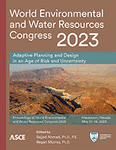A Machine Learning-Based Surrogate Model for Coupled Hydraulic and Water Quality Simulation in Water Distribution Networks
Publication: World Environmental and Water Resources Congress 2023
ABSTRACT
Ensuring consistent and high-level water quality is paramount for water utilities to meet health requirements and attain customer satisfaction. To this end, water utilities need to constantly surveil all relevant water quality parameters, for example, chlorine-concentration, as well as to optimally control dosage rates in their drinking water distribution systems (DWDSs). Simulation models coupling DWDS hydraulics and water quality have been well established and highly accurate. However, they are computationally very expensive such that optimization of control parameters may only be possible to a very limited extent. In this work, we are proposing the use of a lightweight, machine learning-based surrogate model for the coupled simulation of hydraulic and water quality parameters that may serve to reduce simulation times and render optimization of control parameters more efficient. The baseline model is system-specific and learns to predict the steady-state hydraulic and water quality state simultaneously based on common inputs to a DWDS model, that is, water demands and dosage rates at reservoir levels. Results indicate good prediction capabilities of the surrogate model with R2 values greater than 0.98 as well as error rates below 0.01% for hydraulic parameters and below 1% for water quality parameters. Some slight spatial trends in the prediction error’s variance are identified for hydraulics as well as for water quality parameters.
Get full access to this chapter
View all available purchase options and get full access to this chapter.
REFERENCES
Abhijith, G., L. Kadinski, and A. Ostfeld. 2021. “Modeling Bacterial Regrowth and Trihalomethane Formation in Water Distribution Systems.” Water, 13 (4): 463. https://doi.org/10.3390/w13040463.
Abhijith, G. R., and S. Mohan. 2021. “Cellular Automata-Based Mechanistic Model for Analyzing Microbial Regrowth and Trihalomethanes Formation in Water Distribution Systems.” J. Environ. Eng., 147 (1): 04020145. https://doi.org/10.1061/(ASCE)EE.1943-7870.0001833.
Abhijith, G. R., and A. Ostfeld. 2022. “Examining the Longitudinal Dispersion of Solutes Inside Water Distribution Systems.” J. Water Resour. Plann. Manage., 148 (6): 04022022. https://doi.org/10.1061/(ASCE)WR.1943-5452.0001562.
Abokifa, A. A., Y. J. Yang, C. S. Lo, and P. Biswas. 2016. “Investigating the role of biofilms in trihalomethane formation in water distribution systems with a multicomponent model.” Water Research, 104: 208–219. https://doi.org/10.1016/j.watres.2016.08.006.
Behzadian, K., Z. Kapelan, D. Savic, and A. Ardeshir. 2009. “Stochastic sampling design using a multi-objective genetic algorithm and adaptive neural networks.” Environmental Modelling & Software, 24 (4): 530–541. https://doi.org/10.1016/j.envsoft.2008.09.013.
Broad, D. R., H. R. Maier, and G. C. Dandy. 2010. “Optimal Operation of Complex Water Distribution Systems Using Metamodels.” J. Water Resour. Plann. Manage., 136 (4): 433–443. https://doi.org/10.1061/(ASCE)WR.1943-5452.0000052.
Brunton, S. L., and J. N. Kutz. 2019. Data-Driven Science and Engineering: Machine Learning, Dynamical Systems, and Control. Cambridge University Press.
Clark, R. M., and M. Sivaganesan. 1998. “Predicting Chlorine Residuals and Formation of TTHMs in Drinking Water.” J. Environ. Eng., 124 (12): 1203–1210. https://doi.org/10.1061/(ASCE)0733-9372(1998)124:12(1203).
Fan, X., X. Zhang, and X. B. Yu. 2021. “Machine learning model and strategy for fast and accurate detection of leaks in water supply network.” J Infrastruct Preserv Resil, 2 (1): 10. https://doi.org/10.1186/s43065-021-00021-6.
Fiedler, F., A. Cominola, and S. Lucia. 2020. “Economic nonlinear predictive control of water distribution networks based on surrogate modeling and automatic clustering.” IFAC-PapersOnLine, 53 (2): 16636–16643. https://doi.org/10.1016/j.ifacol.2020.12.793.
Garzón, A., Z. Kapelan, J. Langeveld, and R. Taormina. 2022. “Machine Learning‐Based Surrogate Modeling for Urban Water Networks: Review and Future Research Directions.” Water Resources Research, 58 (5). https://doi.org/10.1029/2021WR031808.
Goodfellow, I., Y. Bengio, and A. Courville. 2016. Deep learning. Adaptive computation and machine learning. Cambridge, Massachusetts: The MIT Press.
Maas, A. L., A. Y. Hannun, and A. Y. Ng. 2013. “Rectifier Nonlinearities Improve Neural Network Acoustic Models.” Proceedings of the 30th International Conference on Machine Learning, 6. Atlanta, Georgia, USA: JMLR.org.
Paszke, A., et al. 2019. PyTorch: An Imperative Style, High-Performance Deep Learning Library. 12. Vancouver, Canada.
Ramsundar, B., and R. B. Zadeh. 2018. TensorFlow for deep learning: from linear regression to reinforcement learning. Beijing: O’Reilly Media.
Rossman, L. A. 2000. EPANET 2 Users Manual.
Rossman, L. A., R. M. Clark, and W. M. Grayman. 1994. “Modeling Chlorine Residuals in Drinking‐Water Distribution Systems.” J. Environ. Eng., 120 (4): 803–820. https://doi.org/10.1061/(ASCE)0733-9372(1994)120:4(803).
Rossman, L. A., H. Woo, M. Tryby, F. Shang, R. Janke, and T. Haxton. 2020. EPANET 2.2 User Manual.
Sayers, W., D. Savic, and Z. Kapelan. 2019. “Performance of LEMMO with artificial neural networks for water systems optimisation.” Urban Water Journal, 16 (1): 21–32. https://doi.org/10.1080/1573062X.2019.1611886.
Shang, F., J. G. Uber, and L. Rossman. 2011. EPANET Multi-Species Extension Software and User’s Manual. U.S. Environmental Protection Agency.
Tzatchkov, V. G., A. A. Aldama, and F. I. Arreguin. 2002. “Advection-Dispersion-Reaction Modeling in Water Distribution Networks.” J. Water Resour. Plann. Manage., 128 (5): 334–342. https://doi.org/10.1061/(ASCE)0733-9496(2002)128:5(334).
Vrachimis, Eliades, Taormina, Ostfeld, Kapelan, Liu, Kyriakou, Pavlou, Qiu, and Polycarpou. 2020. “BattLeDIM 2020 Problem Announcement and Description.” Zenodo. https://doi.org/10.5281/ZENODO.3902046.
Information & Authors
Information
Published In
History
Published online: May 18, 2023
ASCE Technical Topics:
- Coupling
- Engineering fundamentals
- Environmental engineering
- Equipment and machinery
- Errors (statistics)
- Hydraulic models
- Mathematics
- Models (by type)
- Parameters (statistics)
- Simulation models
- Statistics
- Structural engineering
- Structural members
- Structural systems
- Water and water resources
- Water management
- Water quality
- Water supply
- Water supply systems
- Water treatment
Authors
Metrics & Citations
Metrics
Citations
Download citation
If you have the appropriate software installed, you can download article citation data to the citation manager of your choice. Simply select your manager software from the list below and click Download.
